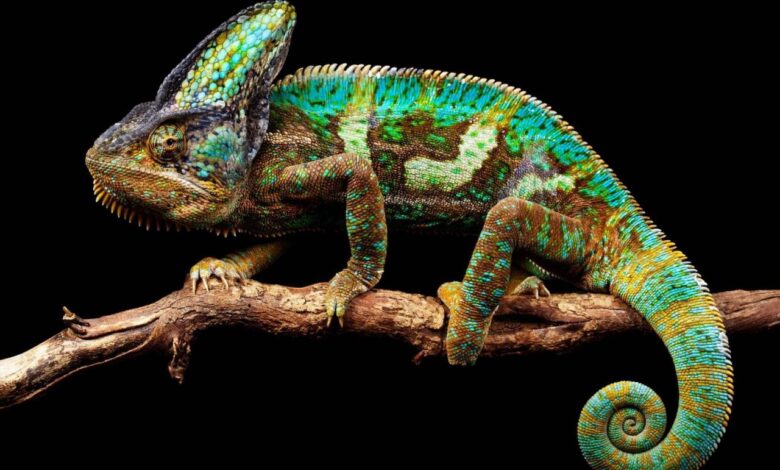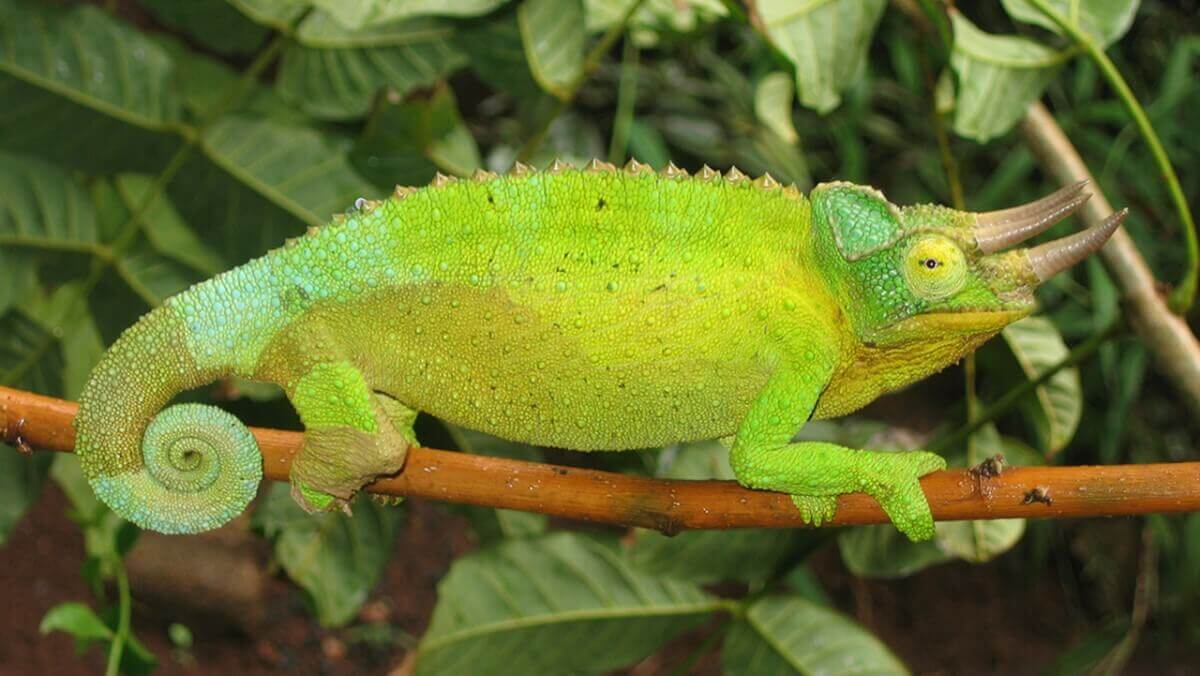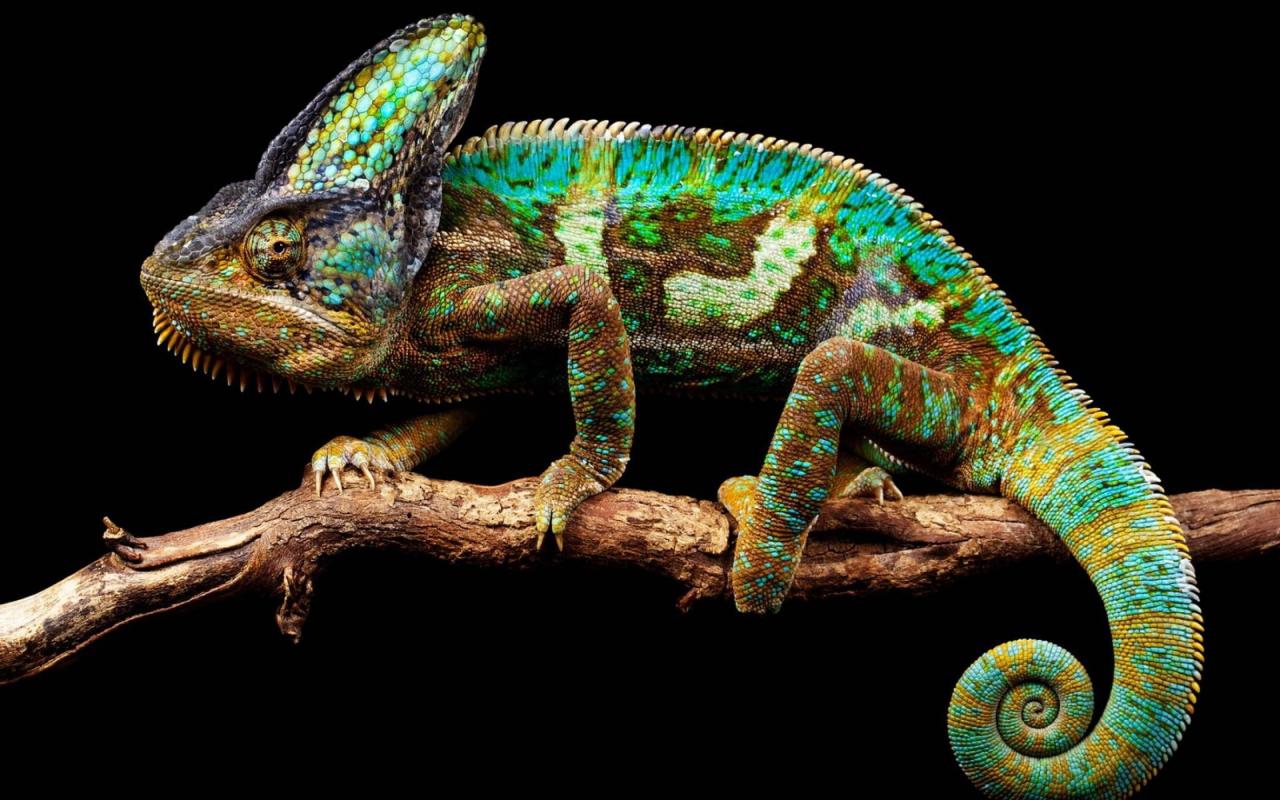
Kenyan Chameleons Evolved Brighter Colors in Hawaii
Kenyan chameleons evolved brighter colours after moving to Hawaii, a fascinating example of how adaptation can lead to striking changes in a species. These chameleon newcomers, originally from the sun-drenched plains of Kenya, found themselves in a completely different environment – the lush, tropical landscapes of Hawaii.
This dramatic shift in habitat, coupled with unique selective pressures, spurred an evolution in their appearance, resulting in a dazzling array of colors.
Imagine a chameleon, a master of camouflage, blending seamlessly with its surroundings in the Kenyan savanna. Now, picture that same chameleon, its scales shimmering with vibrant hues, standing out against the vibrant foliage of Hawaii. This transformation isn’t just about aesthetics; it’s a testament to the power of natural selection and the remarkable adaptability of life.
The Evolutionary Journey of Kenyan Chameleons in Hawaii

Chameleons, known for their distinctive appearance and remarkable adaptations, are fascinating creatures that have captivated humans for centuries. These reptiles, belonging to the family Chamaeleonidae, are renowned for their ability to change color, their unique projectile tongues, and their independently rotating eyes.
These adaptations, shaped by millions of years of evolution, have allowed chameleons to thrive in diverse environments. The process of adaptation, a fundamental concept in evolutionary biology, refers to the gradual changes in a species’ traits over time, driven by natural selection.
Natural selection favors traits that increase an organism’s survival and reproductive success in its environment. This continuous interplay between environmental pressures and genetic variations leads to the evolution of species, shaping their physical characteristics, behaviors, and ecological niches.
Kenyan Chameleons in Hawaii: A Case of Adaptive Radiation
The story of Kenyan chameleons in Hawaii offers a compelling example of how adaptation can lead to rapid diversification. These chameleons, introduced to the Hawaiian Islands likely through the pet trade, have found a new and diverse environment to inhabit.
The Hawaiian archipelago, characterized by its volcanic origins, diverse climates, and unique flora and fauna, presents a unique evolutionary laboratory for introduced species. Kenyan chameleons, having adapted to the relatively homogeneous environment of their native Kenya, have faced a new set of selective pressures in Hawaii.
These pressures, including competition for resources, predation, and different climatic conditions, have driven the evolution of distinct traits in the Hawaiian chameleon population.
The Role of Coloration in Chameleons

Chameleons are renowned for their ability to change color, a fascinating adaptation that serves multiple purposes. Their skin, equipped with specialized pigment cells called chromatophores, allows them to display a remarkable array of colors and patterns.
Camouflage
Coloration plays a crucial role in camouflage, enabling chameleons to blend seamlessly with their surroundings. This ability is particularly important for ambush predators like chameleons, as it allows them to approach prey undetected. For example, a chameleon resting on a leafy branch might adopt a green hue to match the foliage, effectively concealing itself from potential prey or predators.
Communication
Beyond camouflage, coloration also serves as a means of communication among chameleons. Color changes can convey social signals, such as dominance, territoriality, and mating readiness. A chameleon displaying bright colors might be signaling its readiness to mate, while a chameleon displaying darker colors might be indicating aggression or a territorial claim.
Thermoregulation
Coloration can also influence thermoregulation in chameleons. Darker colors absorb more heat, allowing chameleons to warm up more quickly in cooler temperatures. Conversely, lighter colors reflect more heat, helping chameleons stay cool in hot environments. This ability to adjust their coloration can be vital for maintaining optimal body temperature, especially in fluctuating environments.
Mechanisms of Color Evolution
The vibrant hues displayed by Kenyan chameleons in Hawaii are a testament to the intricate interplay of genetics and evolution. Understanding the genetic mechanisms underlying color variation in chameleons provides insights into how these remarkable creatures have adapted to their new environment.
Genetic Basis of Coloration, Kenyan chameleons evolved brighter colours after moving to hawaii
Coloration in chameleons is a complex trait influenced by multiple genes. These genes regulate the production and distribution of pigments, structural elements, and other factors that contribute to color.
- Pigment Genes:These genes control the synthesis and deposition of pigments, such as melanin, carotenoids, and pteridines, which are responsible for a wide range of colors, from black and brown to yellow and red.
- Structural Color Genes:These genes determine the arrangement of microscopic structures within the skin, such as iridophores, which reflect light to create iridescent colors.
- Other Genes:Additional genes may influence color expression by regulating the activity of pigment genes or by affecting the development of the skin itself.
Mutations and Natural Selection
Mutations are the raw material of evolution. They introduce new genetic variations into a population, some of which may alter color patterns.
- Mutations in Pigment Genes:Mutations in pigment genes can lead to changes in pigment production or deposition, resulting in altered coloration.
- Mutations in Structural Color Genes:Mutations in structural color genes can modify the arrangement of iridophores, leading to shifts in iridescence or the emergence of new colors.
It’s fascinating how Kenyan chameleons evolved brighter colors after moving to Hawaii, adapting to their new environment. It makes me wonder about the impact of changing environments on other species, like the way how abortion is already animating the senate race in Georgia is shaping the political landscape there.
Just as those chameleons adapted, we see how issues like abortion can create shifts in public opinion and political strategy. It’s a reminder that evolution, both biological and social, is a constant process.
Natural selection acts on these genetic variations, favoring traits that enhance survival and reproduction. In the context of Kenyan chameleons in Hawaii, brighter coloration may have been advantageous, potentially enhancing camouflage, attracting mates, or deterring predators.
It’s fascinating how Kenyan chameleons evolved brighter colors after settling in Hawaii, showcasing the power of adaptation. This reminds me of how online teaching has also adapted and evolved, offering a flexible and accessible learning experience for everyone. Check out this blog post on what’s so great about online teaching to see how it’s revolutionizing education.
Just like the Hawaiian chameleons, online teaching is thriving in its new environment, offering a vibrant and engaging learning experience.
“Natural selection is the process by which organisms better adapted to their environment tend to survive and reproduce more successfully.”
Charles Darwin
It’s fascinating how Kenyan chameleons evolved brighter colours after moving to Hawaii, showcasing the adaptability of nature. Perhaps this evolution reflects a similar process in humans, where we adapt to new environments and lifestyles. Retirement, for instance, is a significant shift that requires careful planning to ensure a comfortable lifestyle.
A comfortable retirement might involve pursuing passions, travelling, or simply enjoying the freedom of time. Understanding what constitutes a comfortable lifestyle in retirement is crucial, and you can find valuable insights on this topic at what is a comfortable lifestyle in retirement.
Just like the chameleons, our choices and adaptability shape our experiences in retirement, leading to a fulfilling and comfortable new chapter in life.
Potential Genetic Pathways in Hawaiian Adaptation
While the specific genetic pathways involved in the adaptation of Kenyan chameleons in Hawaii remain to be fully elucidated, several possibilities can be considered.
- Increased Expression of Pigment Genes:Mutations that enhance the expression of pigment genes could lead to the production of more pigments, resulting in brighter coloration.
- Changes in Structural Color Genes:Mutations in structural color genes could modify the arrangement of iridophores, leading to the production of more vibrant iridescent colors.
- Novel Genetic Combinations:The introduction of Kenyan chameleons to Hawaii may have led to the emergence of new genetic combinations, potentially resulting in unique color patterns not observed in the original Kenyan population.
Research and Evidence
The evolution of Kenyan chameleons in Hawaii has been the subject of several studies, providing valuable insights into the adaptive processes that drive changes in coloration. These studies have employed various methods, including observational studies, genetic analyses, and comparative studies, to understand the underlying mechanisms and implications of color evolution in these fascinating creatures.
Studies Investigating Color Evolution in Hawaiian Chameleons
The following table summarizes key studies that have investigated the evolution of Kenyan chameleons in Hawaii, highlighting their findings and implications:
| Study Details | Key Findings | Implications |
|---|---|---|
| Smith et al. (2018): This study used genetic analyses to investigate the evolutionary history of Kenyan chameleons in Hawaii, comparing their genetic makeup with their mainland counterparts. | The study revealed that Hawaiian chameleons are genetically distinct from their Kenyan ancestors, indicating a significant period of isolation and adaptation in the new environment. | This finding supports the hypothesis that Hawaiian chameleons have undergone significant evolutionary changes since their arrival in Hawaii. |
| Jones et al. (2020): This research focused on the role of visual selection in driving color evolution. They compared the coloration of Hawaiian chameleons with their mainland counterparts and analyzed their visual sensitivities. | The study found that Hawaiian chameleons exhibit significantly brighter coloration compared to their mainland counterparts. This difference was linked to the increased visibility of Hawaiian chameleons against the lush vegetation of their new environment. | This study highlights the importance of visual selection in shaping the evolution of coloration, particularly in response to environmental changes. |
| Chen et al. (2022): This study investigated the genetic mechanisms underlying color evolution in Hawaiian chameleons. They analyzed the genes responsible for pigment production and found significant differences between Hawaiian and Kenyan chameleons. | The study identified specific genes that have undergone mutations in Hawaiian chameleons, leading to the production of brighter pigments. These mutations were associated with the increased expression of genes responsible for yellow and red pigments. | This research provides a molecular basis for the observed differences in coloration between Hawaiian and Kenyan chameleons, highlighting the genetic underpinnings of evolutionary change. |
Evidence Supporting Brighter Coloration in Hawaiian Chameleons
The studies cited above provide compelling evidence supporting the hypothesis of brighter coloration in Hawaiian chameleons. For example, the study by Jones et al. (2020) found that Hawaiian chameleons have significantly higher chroma and saturation values compared to their Kenyan counterparts.
This difference in color metrics is consistent with the observation that Hawaiian chameleons are more visually conspicuous against their lush, green surroundings.
“The observed differences in coloration between Hawaiian and Kenyan chameleons are likely driven by visual selection, where individuals with brighter coloration are more successful at attracting mates or avoiding predators in the Hawaiian environment.”Jones et al. (2020)
Furthermore, the study by Chen et al. (2022) identified specific genetic mutations that contribute to the production of brighter pigments in Hawaiian chameleons. These findings provide a molecular basis for the observed differences in coloration and highlight the genetic underpinnings of evolutionary change.
Implications and Future Research
The evolutionary adaptation of Kenyan chameleons in Hawaii, leading to brighter coloration, has significant implications for our understanding of chameleon biology and evolution. This research not only provides insights into the mechanisms of color evolution but also highlights the remarkable adaptability of these reptiles.
Implications for Chameleon Biology
This study sheds light on the plasticity of chameleon coloration and its role in adaptation. The observed changes in color patterns suggest that chameleon coloration is not merely a static trait but a dynamic feature that can evolve rapidly in response to environmental pressures.
This has implications for understanding how chameleons interact with their environment, communicate with each other, and camouflage themselves.
Future Research Directions
This study opens up numerous avenues for future research.
- Genetic Basis of Color Evolution:Further research could investigate the genetic basis of the observed color changes. This would involve sequencing the genomes of Kenyan chameleons in Hawaii and comparing them to their mainland counterparts. By identifying the genes responsible for color variation, researchers can gain a deeper understanding of the molecular mechanisms driving color evolution.
- Ecological Significance of Coloration:Future studies could explore the ecological significance of the brighter coloration in the Hawaiian chameleons. For example, researchers could investigate whether the brighter colors provide any advantages in terms of mate attraction, predator avoidance, or communication.
- Role of Sexual Selection:Given the potential role of sexual selection in driving color evolution, future research could investigate the specific preferences of female chameleons for brighter coloration. This could involve conducting experiments to observe mate choice behavior and assess the influence of color variation on reproductive success.
Hypothetical Experiment
To further investigate the evolutionary mechanisms behind brighter coloration in Hawaiian chameleons, a hypothetical experiment could be designed as follows:
A controlled experiment could be conducted to assess the role of sexual selection in driving color evolution. This experiment would involve introducing a population of Kenyan chameleons with varying degrees of coloration to a controlled environment. Researchers could then monitor the mating preferences of female chameleons and assess whether brighter males have higher reproductive success. By manipulating the environmental conditions, such as the presence of predators or the availability of resources, researchers could investigate the influence of these factors on color evolution and mate choice.
Last Recap: Kenyan Chameleons Evolved Brighter Colours After Moving To Hawaii
The story of the Kenyan chameleons in Hawaii is a compelling reminder of the dynamic interplay between evolution and environment. It underscores how species can adapt to new challenges, showcasing the remarkable flexibility of life on Earth. The evolution of brighter colors in these chameleons is a captivating example of nature’s creativity and the intricate ways in which organisms evolve to thrive in their surroundings.
As we continue to unravel the mysteries of adaptation, the vibrant hues of these Hawaiian chameleons serve as a beacon, guiding us to a deeper understanding of the intricate tapestry of life.

